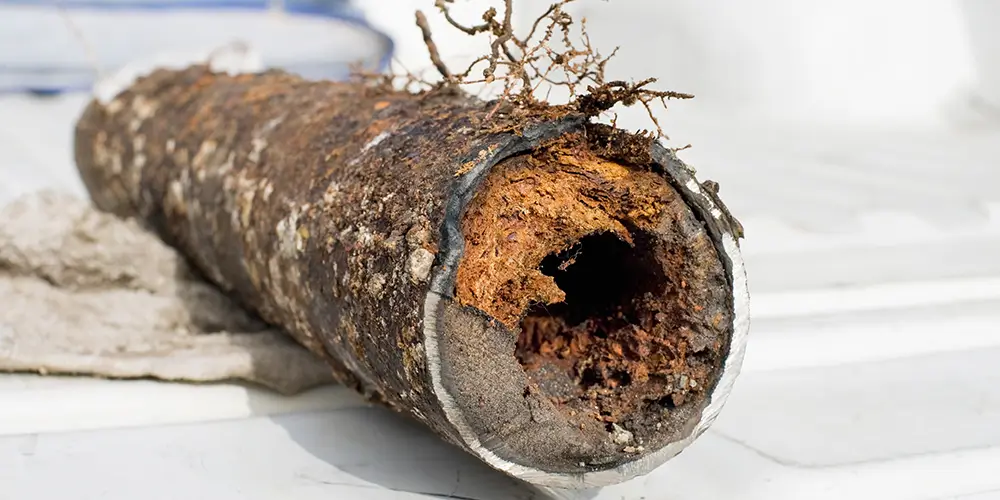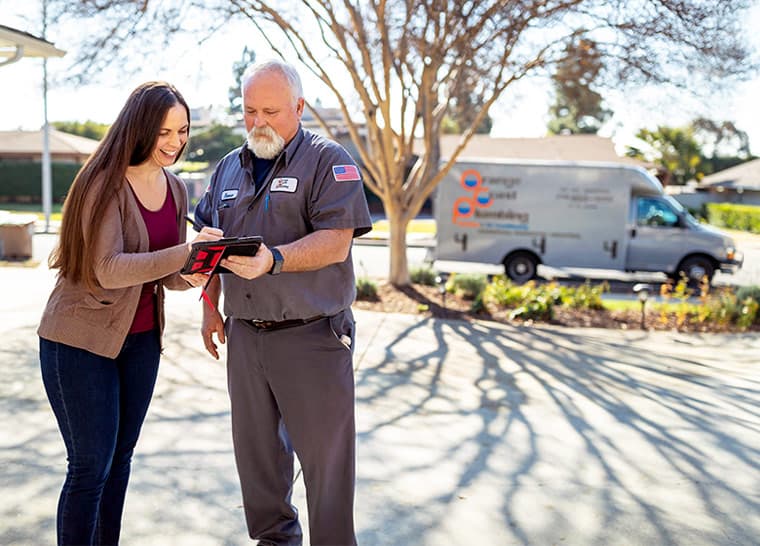Trees love sewage. That gorgeous crape myrtle tree that gives you so much pleasure when it blooms? It will suck up sewage if you let it.
So let’s think about it for a second.
- Trees are thirsty, needing 10 gallons of water per day for every inch of trunk diameter.
- California is in the grip of recent droughts. We water our plants far less than we used to.
- The subsurface soil is also dryer. In some species of trees, the taproot runs only three feet deep.
- Where can a poor tree go for a drink? Your sewer pipe, natch.
Trees don’t get cholera or hepatitis. E. coli don’t faze them. What’s waste to you is a smorgasbord to a tree, loaded with life-giving fluid and nutrients.
Perhaps now you’ll view your beloved crape myrtle through a different lens.
And unfortunately, what works for the tree may not work for you when roots clog the drain pipe and sewage backs up into your home.
How Tree Roots Work (the Lesson You Slept through in Biology)
Trees have vast and complex root systems reaching about a third of the size of the tree itself.
A tree seeks oxygen, moisture, and nutrients in the soil, absorbing them through feeder roots and root hairs into the primary root and eventually the trunk, branches, leaves, etc.
During a drought, tree roots spread out wider than ever. They hone in on your sewer pipe like a honey bee seeking nectar.
Even in a treeless yard, roots in sewer lines can be a problem. The roots may come from plants in another yard.
How Do Roots Get into Sewer Lines?
A tree’s root hairs and feeder roots can fit into a pipe’s joints, especially when joints are old and feeble. Why do roots always seem to clog old lines? Because they’re the easiest to infiltrate.
Once they’re in, the roots throw a party. They drink their fill and grow fat. They proliferate. They also collect dirt, grease, and other stuff that enters the pipe, slowing the sewage flow and eventually blocking it completely. They might exert enough pressure on pipe walls to break or collapse them.
Some Pipes Are More Vulnerable to Root Invasion than Others
Clay Pipes Are a Root System’s BFF
When was your home built? Before or after 1970? The #1 song that year was Bridge Over Troubled Water.
It was also the year (more or less) when sewage clay pipes were phased out and replaced by PVC, concrete, or plastic corrugated tubing.
Clay pipes are the favorite of root systems. Clay is porous; moisture seeps in, and baby roots enter looking for a sugar high.
It’s also easier for tree roots to break clay pipes than other types.
The current industry standard for sewage lines is PVC, which is less susceptible to root invasion.
Clay pipes? That’s problem #1.
Old pipes? That’s problem #2.
Tree roots can get into any pipe through the joints or tiny cracks that develop through years of use and abuse. Other factors that can damage pipes include:
- Faulty Installation
- Poor ground support
- Local soil conditions.
- Corrosive chemicals
- Hard water
Galvanized Steel Pipes Also Invite Root Invasion
Plumbers no longer favor galvanized steel piping, but it exists in many older homes.
The steel is coated with zinc, which corrodes over time and can open a door for tree roots. Roots in galvanized pipes are tough (and expensive) to remove because of the nature of the corrosion. Repiping may be your only option.
How Can We Be Sure Tree Roots Are the Problem?
Unless you dig up the sewer pipe — good luck if the line extends 60 feet or more — the only way to detect root damage is with a sewer camera inspection. Remember that sewer cam you kept in the garage all those years? You should have hung onto it.
Obviously, at this point, you’re beyond hope of a DIY repair. You’ve called Orange Coast or a local plumber, and after diagnosing the problem, the plumber lays out your options, which range from chemical treatment to trenchless repair.
How to Repair a Pipe Clogged by Tree Roots
If the tree root invasion is minimal, you may be able to use chemical treatments, such as root killers, to clear the pipe.
But if the damage is severe or embedded deep in the pipe, your plumber may recommend trenchless repair methods like pipe bursting or relining.
Unfortunately, these repairs can get pricey, depending on how much is damaged and how long it takes.
Chemical Tree Root Killers
Root killers contain copper sulfate, which is toxic to plants and trees.
If you have clay pipes, you should never use copper sulfate or any other chemical tree root killer in your sewer line because the corrosive chemicals will weaken them further.
Also, chemical treatments can damage landscaping and enter groundwater sources.
Leave the job to a plumbing professional who will know how and where to apply the chemicals.
Hydro Jetting
Hydro jetting is the least expensive repair option. It involves shooting streams of high-pressure water through your sewer pipes to blast away roots and debris.
As a preventive measure, it can clear out tree roots before they do severe damage to the pipe.
However, hydro jetting won’t repair collapsed or broken pipes.
Pipe Bursting or Pipe Relining (Trenchless Repair)
Trenchless pipe repair may be the only option if you have severe root invasion or broken pipes. It’s a way to replace existing plumbing without digging trenches (hence its name).
It works in two ways:
- Breaking the old pipe and a new pipe inside the path you’ve created (pipe bursting)
- Lining the old pipe with an epoxy sleeve (pipe relining or cured-in-place piping).
Both methods are more expensive than hydro jetting but much cheaper (and less disruptive) than digging up your sewer lines.
What Can You Do To Prevent Tree Root Invasion?
The best way to prevent tree roots from invading your sewer line is to keep them away with a root barrier.
A root barrier is a strip of heavy plastic or metal installed around the pipe’s perimeter. It should be buried three feet deep and come up two feet high, creating an impenetrable wall between the line and the tree.
Check for tree roots if you’re replacing an old sewer line. Assess any other potential problems (like ground support) while you’re at it.
You might also consider treating the area with a chemical root killer or periodically maintaining your sewer line with hydro jetting.
A professional plumber at Orange Coast Plumbing can help you assess the problem and recommend a remedy that fits your budget. Call us today!
FAQs: Tree Roots in Sewer Lines
Q: What should I do if I find tree roots in my sewer line?
If you notice signs of a clogged or damaged sewer line, such as slow drainage, gurgling sounds from drains, or foul odors coming from your pipes, call a professional plumber for an inspection. The pros use specialized equipment like sewer cameras to accurately diagnose the issue and recommend the best course of action.
Q: How often should I have my sewer lines checked for root invasion?
We recommend having your sewer lines inspected every 1–2 years, especially if you have older plumbing or trees near your main water line. Catching root intrusion early on can save you time, money, and headaches in the long run.
Q: Can tree roots cause permanent damage to my sewer line?
Yes, roots can grow into small cracks or joints, enlarging them and eventually collapsing the pipe. Left untreated, this can result in costly repairs or replacements.
Q: What types of pipes are most resistant to tree root invasion?
PVC and concrete pipes are the most resistant to root invasion. PVC pipes are non-porous and have tightly sealed joints, which prevent roots from finding entry points. However, no pipe is entirely immune.
Q: Are chemical treatments safe for all types of pipes?
No. For example, corrosive chemicals like copper sulfate can weaken clay pipes and damage the surrounding environment. Always consult a professional plumber before using chemical treatments.
Q: Will removing a tree eliminate the risk of root invasion?
Not necessarily. Even after a tree is removed, its root system can remain alive and continue to grow for years. Dead roots can also decompose, exacerbating existing pipe cracks.
Q: How effective is trenchless repair for addressing root damage?
Trenchless repair is highly effective for addressing root damage. It avoids the need for extensive digging and can be completed relatively fast. Both pipe bursting and pipe relining methods provide long-term solutions by replacing or reinforcing damaged pipes.
Q: Can I prevent tree roots from reaching my pipes in new construction?
Yes, you can install root barriers and strategically plant trees far away from sewer lines. Consulting a landscaping professional about tree placement and root growth potential can also reduce future problems.


